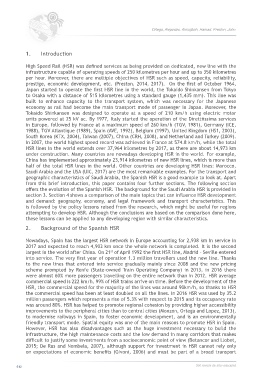Page 514 - 360.revista de Alta Velocidad - Nº 6
P. 514
Ortega, Alejandro. Almujibah, Hamad. Preston, John.
1. Introduction
High Speed Rail (HSR) was defined services as being provided on dedicated, new line with the
infrastructure capable of operating speeds of 250 kilometres per hour and up to 350 kilometres
per hour. Moreover, there are multiple objectives of HSR such as speed, capacity, reliability,
prestige, economic development, etc. (Preston, 2014, 2017). On the first of October 1964,
Japan started to operate the first HSR line in the world, the Tokaido Shinkansen from Tokyo
to Osaka with a distance of 515 kilometres using a standard gauge (1,435 mm). This line was
built to enhance capacity to the transport system, which was necessary for the Japanese
economy as rail had become the main transport mode of passenger in Japan. Moreover, the
Tokaido Shinkansen was designed to operate at a speed of 210 km/h using electric motor
units powered at 25 kV ac. By 1977, Italy started the operation of the Direttiissima services
in Europe, followed by France at a maximum speed of 260 km/h (TGV, 1981), Germany (ICE,
1988), TGV Atlantique (1989), Spain (AVE, 1992), Belgium (1997), United Kingdom (HS1, 2003),
South Korea (KTX, 2004), Taiwan (2007), China (CRH, 2008), and Netherland and Turkey (2009).
In 2007, the world highest speed record was achieved in France at 574.8 km/h, while the total
HSR lines in the world extends over 37,964 kilometres by 2017, as there are about 14,973 km
under construction. Many countries are nowadays developing HSR in the world. For example,
China has implemented approximately 23,914 kilometres of new HSR lines, which is more than
half of the total HSR lines in the world. Other countries are developing HSR lines: Morocco,
Saudi Arabia and the USA (UIC, 2017) are the most remarkable examples. For the transport and
geographic characteristics of Saudi Arabia, the Spanish HSR is a good example to look at. Apart
from this brief introduction, this paper contains four further sections. The following section
offers the evolution of the Spanish HSR. The background for the Saudi Arabia HSR is provided in
section 3. Section 4 shows a comparison of the main topics that can influence HSR development
and demand: geography, economy, and legal framework and transport characteristics. This
is followed by the policy lessons raised from the research, which might be useful for regions
attempting to develop HSR. Although the conclusions are based on the comparison done here,
these lessons can be applied to any developing region with similar characteristics.
2. Background of the Spanish HSR
Nowadays, Spain has the largest HSR network in Europe accounting for 2,938 km in service in
2017 and expected to reach 4,903 km once the whole network is completed. It is the second
largest in the world after China. On 21 of April 1992 the first HSR line, Madrid – Seville entered
st
into service. The very first year of operation 1.3 million travellers used the new line. Thanks
to the new lines that entered into service gradually mainly since 2008 and the new pricing
scheme prompted by Renfe (State-owned Train Operating Company) in 2013, in 2016 there
were almost 60% more passengers travelling on the entire network than in 2012. HSR average
commercial speed is 222 km/h, 99% of HSR trains arrive on time. Before the development of the
HSR, the commercial speed for the majority of the lines was around 90km/h, so thanks to HSR
the commercial speed has been at least doubled on all the lines. In 2016 HSR was used by 35.2
million passengers which represents a rise of 5.3% with respect to 2015 and its occupancy rate
was around 80%. HSR has helped to promote regional cohesion by providing higher accessibility
improvements to the peripheral cities than to central cities (Monzon, Ortega and Lopez, 2013),
to modernise railways in Spain, to foster economic development, and is an environmentally
friendly transport mode. Spatial equity was one of the main reasons to promote HSR in Spain.
However, HSR has also disadvantages such as the huge investment necessary to build the
infrastructure, the high maintenance costs and the low demand in many corridors that makes
difficult to justify some investments from a socioeconomic point of view (Betancor and Llobet,
2015; De Rus and Nombela, 2007), although support for investment in HSR cannot rely only
on expectations of economic benefits (Givoni, 2006) and must be part of a broad transport
512 360.revista de alta velocidad

